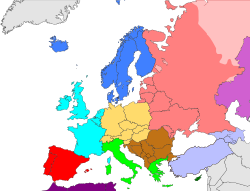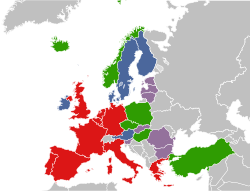사용자:배우는사람/문서:Europe
유럽(Europe)[편집]
Clickable map of Europe, showing one of the most commonly used geographical boundaries[1] blue = states in both Europe and Asia; green = sometimes included within Europe but geographically outside Europe's boundaries |

The World Factbook에 따른 구분[편집]
 |
 |
Clickable map of Europe, showing one of the most commonly used geographical boundaries[4] blue = states in both Europe and Asia; green = sometimes included within Europe but geographically outside Europe's boundaries |
UN 통계국에 따른 유럽의 구분[편집]
 |
 Western Europe |
Clickable map of Europe, showing one of the most commonly used geographical boundaries[5] blue = states in both Europe and Asia; green = sometimes included within Europe but geographically outside Europe's boundaries |
 |
 |
유럽의 지역 구분[편집]



회원국
준 회원국
옵저버
준 가맹국

유럽의 지역 구분은 매우 다양해서, 모두가 동의할만한 공통 의견을 찾기 쉽지 않다. 정확한 정의는 존재하지 않지만, 다음은 일반적으로 통용되는 분류이다.
동유럽[편집]
서유럽[편집]
남유럽[편집]
 스페인 (발레아레스 제도 포함)
스페인 (발레아레스 제도 포함) 안도라
안도라 지브롤터
지브롤터 포르투갈 (마데이라 제도와 아조레스 제도 포함)
포르투갈 (마데이라 제도와 아조레스 제도 포함) 모나코
모나코 프랑스 (북부와 알프스 산맥, 대서양 부분은 포함하지 않고, 코르시카 섬은 포함)
프랑스 (북부와 알프스 산맥, 대서양 부분은 포함하지 않고, 코르시카 섬은 포함) 몰타 (반도에 속하지는 않으나, 지리적으로 가깝기 때문에 함께 분류)
몰타 (반도에 속하지는 않으나, 지리적으로 가깝기 때문에 함께 분류) 바티칸 시국
바티칸 시국 산마리노
산마리노 이탈리아 (알프스 산맥 부분은 포함하지 않고, 사르데냐 섬과 시칠리아 섬은 포함))
이탈리아 (알프스 산맥 부분은 포함하지 않고, 사르데냐 섬과 시칠리아 섬은 포함)) 그리스 (에게 해 제도, 크리티 지역, 이오니아 제도 포함)
그리스 (에게 해 제도, 크리티 지역, 이오니아 제도 포함) 마케도니아 공화국
마케도니아 공화국 몬테네그로
몬테네그로 보스니아 헤르체고비나
보스니아 헤르체고비나 불가리아
불가리아 세르비아
세르비아 알바니아
알바니아 크로아티아
크로아티아
북유럽[편집]
중앙유럽[편집]
서유럽(Western Europe)[편집]
 Western Europe |
 |
중앙유럽(Central Europe)[편집]
 Western Europe |
 |
동유럽(Eastern Europe)[편집]
 Western Europe |
 Eastern Europe, Northern and Central Asia Division East Central and South-East Europe Division |
 Eastern Europe Southeastern Europe Transcontinental |
 |
참고 문헌[편집]
- ↑ The map shows one of the most commonly accepted delineations of the geographical boundaries of Europe, as used by National Geographic and Encyclopaedia Britannica. Whether countries are considered in Europe or Asia can vary in sources, for example in the classification of the CIA World Factbook or that of the BBC.
- ↑ “European regions by the UN”. Permanent comittee on geographical names.
- ↑ “Subdivision of Europe” (PDF). United Nations Group of Experts on Geographical Names.
- ↑ The map shows one of the most commonly accepted delineations of the geographical boundaries of Europe, as used by National Geographic and Encyclopaedia Britannica. Whether countries are considered in Europe or Asia can vary in sources, for example in the classification of the CIA World Factbook or that of the BBC.
- ↑ The map shows one of the most commonly accepted delineations of the geographical boundaries of Europe, as used by National Geographic and Encyclopaedia Britannica. Whether countries are considered in Europe or Asia can vary in sources, for example in the classification of the CIA World Factbook or that of the BBC.
- ↑ “Western Europe”. 《National Geographic Society》. NationalGeographic.com. 2009. 2009년 9월 28일에 확인함.
- ↑ United Nations Statistics Division - Geographical Names and Information Systems

